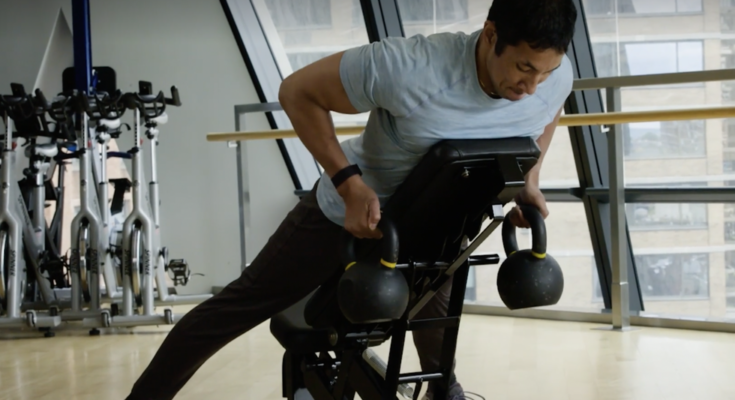In the quest for optimal fitness and well-being, the health of our shoulders is often overlooked, yet it plays a pivotal role in daily activities and athletic performance.
This comprehensive guide outlines five essential exercises designed to enhance shoulder strength, flexibility, and resilience, ensuring they remain healthy and functional.
1. Shoulder Circles: A Warm-Up for Mobility
Shoulder circles are an essential exercise for anyone looking to improve their upper body mobility and reduce the risk of shoulder injuries. This simple, yet effective movement can be integrated into any workout routine, serving as a perfect warm-up for athletes, gym-goers, and desk workers alike. Here’s a guide on how to perform shoulder circles correctly, their benefits, and variations to accommodate all fitness levels.
How to Perform Shoulder Circles Correctly
To ensure maximum benefit and minimize the risk of injury, follow these steps to perform shoulder circles properly:
- Stand Upright: Begin by standing with your feet shoulder-width apart. Keep your back straight and your arms relaxed at your sides.
- Start with Small Circles: Slowly rotate your shoulders in a forward motion, making small circles. Gradually increase the size of the circles as your shoulders start to warm up.
- Reverse the Direction: After completing a set of forward circles, switch directions and rotate your shoulders backward, again starting with small circles and gradually increasing their size.
- Maintain Control: Keep the movement controlled and smooth throughout the exercise. Avoid jerky motions to prevent strain.
Perform this exercise for about 30 seconds to 1 minute in each direction, ensuring your shoulders are thoroughly warmed up.
Benefits of Shoulder Circles
Incorporating shoulder circles into your warm-up routine offers several key benefits:
- Increases Mobility: Regularly performing shoulder circles helps improve the range of motion and flexibility in the shoulder joints and surrounding muscles.
- Reduces Injury Risk: By warming up the muscles and joints, shoulder circles can significantly reduce the risk of shoulder-related injuries during exercise.
- Enhances Circulation: This exercise promotes blood flow to the shoulder region, preparing the muscles for more intensive activity.
Variations for All Fitness Levels
To accommodate individuals at different fitness levels and with varying mobility, consider these variations of shoulder circles:
- Seated Shoulder Circles: For those who find standing for extended periods challenging, performing shoulder circles while seated is an effective alternative.
- Resistance Band Shoulder Circles: Adding a resistance band to the exercise can increase the intensity, providing a more challenging workout for those looking to advance their mobility exercises.
- One-arm Shoulder Circles: Focusing on one arm at a time allows for a more concentrated effort on each shoulder, beneficial for addressing imbalances or rehabilitating injuries.
By incorporating shoulder circles into your routine, you’re taking a significant step towards enhancing your mobility, ensuring your shoulders remain healthy, flexible, and ready for any physical activity. Remember to perform this exercise with care, listening to your body and adjusting the intensity and variations according to your fitness level and mobility needs.
2. Arm Across the Chest Stretch: Flexibility and Relief
The Arm Across the Chest Stretch is a simple yet effective exercise designed to improve shoulder flexibility and provide relief from tightness. Perfect for individuals of all fitness levels, this stretch can be easily integrated into your daily routine. Here, we present a step-by-step guide to performing the stretch correctly, discuss its benefits for shoulder flexibility, and highlight important precautions to ensure safety and prevent overstretching.
Step-by-Step Guide
- Begin in a Standing or Seated Position: Start by standing or sitting upright in a comfortable position. Ensure your spine is straight and your shoulders are relaxed.
- Extend Your Right Arm: Extend your right arm straight in front of you at shoulder height.
- Bring Your Arm Across Your Chest: Gently pull your right arm across your chest with your left hand. You can place your left hand either on your forearm or your elbow for support.
- Hold the Stretch: Maintain this position, holding the stretch for 15-30 seconds. You should feel a gentle stretch across the back of your right shoulder.
- Release and Repeat: Carefully release the stretch and return to the starting position. Repeat the process with your left arm.
Benefits for Shoulder Flexibility and Relief
Incorporating the Arm Across the Chest Stretch into your daily routine can have significant benefits for shoulder flexibility. This exercise targets the shoulders, upper back, and the triceps, helping to reduce muscle stiffness and improve range of motion. It is particularly beneficial for individuals who spend long hours at a desk or engage in activities that tend to overuse the shoulder muscles.
Precautions to Avoid Overstretching
While the Arm Across the Chest Stretch is generally safe for most people, it’s important to take certain precautions to avoid injury:
- Listen to Your Body: Never force the stretch beyond what feels comfortable. You should feel a gentle pull, not pain.
- Maintain Proper Form: Keep your spine aligned and avoid twisting your body to reach further.
- Avoid Bouncing: Perform the stretch in a smooth, steady movement. Bouncing can lead to muscle strain.
- Consult a Professional: If you have existing shoulder injuries or conditions, consult with a healthcare professional or a certified fitness instructor before attempting new stretches.
By following these guidelines, you can safely enjoy the flexibility and relief benefits of the Arm Across the Chest Stretch. Integrating this simple exercise into your routine can significantly improve your shoulder mobility and contribute to overall muscular health.
3. Side-Lying External Rotations: Strengthening the Rotator Cuff
Strengthening your rotator cuff is crucial for maintaining shoulder health and mobility. One effective exercise to achieve this is the Side-Lying External Rotation. Here’s how you can perform this exercise with proper form, understand its importance, and safely progress over time.
How to Perform Side-Lying External Rotations
- Choose the Right Side: Begin by lying on your side, with the arm you’re not working on underneath you for support. Use a pillow or folded towel for head comfort if necessary.
- Position Your Arm Correctly: Bend the elbow of your working arm to a 90-degree angle, keeping the elbow pinned to your side. Hold a light weight in your hand. No weight? Start with just your hand or a small water bottle.
- Execute the Movement: Keeping your elbow at your side, slowly rotate your forearm upwards until it is perpendicular to the floor. Ensure your movement is controlled and focused.
- Return to Start: Slowly bring your arm back to the starting position, maintaining control throughout the movement.
Repeat this exercise for 10-15 repetitions, aiming for 2-3 sets on each arm.
Importance of Strengthening the Rotator Cuff
The rotator cuff is a group of muscles and tendons that stabilize the shoulder joint. Strengthening these muscles is vital for:
- Preventing shoulder injuries.
- Enhancing overall shoulder function.
- Supporting daily activities and sports performance.
Regularly performing exercises like the Side-Lying External Rotation can contribute significantly to your shoulder’s health and longevity.
Progressing Safely Over Time
- Start Light: Begin with very light weights or no weight at all. The focus should be on form and muscle engagement.
- Gradual Increase: As the exercise becomes easier, gradually increase the weight. A good rule of thumb is to increase the weight by the smallest amount available once you can comfortably perform 15 repetitions with good form.
- Listen to Your Body: It’s crucial to pay attention to your body’s signals. If you experience any pain, especially in the shoulder area, take a step back and consult with a healthcare professional.
By incorporating Side-Lying External Rotations into your routine, focusing on proper form, and progressively increasing the challenge, you’ll be taking a significant step towards better shoulder health and function. Remember, consistency is key, and it’s always better to start with lighter weights and increase gradually to prevent injury.
5. Wall Slides: Improving Posture and Shoulder Alignment
Wall slides are an effective exercise designed to enhance your posture and align your shoulders properly. Not only do they help in correcting slouched shoulders, but they also strengthen the muscles around the shoulder blades and upper back. Here’s a simple guide on how to perform wall slides effectively, along with tips to increase their intensity as you progress.
How to Perform Wall Slides Effectively
- Start Position: Stand with your back against a wall. Your feet should be about shoulder-width apart and slightly away from the wall. Ensure your entire back, including the back of your head, is in contact with the wall.
- Arm Position: Extend your arms upwards along the wall, keeping your palms facing outward and your elbows slightly bent. Your goal is to form a “Y” shape with your arms.
- The Slide: Slowly slide your arms down the wall, bending your elbows, and try to bring them as close to your sides as possible. Imagine you’re trying to squeeze something between your shoulder blades.
- Return: Gradually extend your arms back to the starting “Y” position.
- Repetition: Aim for 10-15 repetitions, focusing on keeping your back and arms in contact with the wall throughout the exercise.
The Role in Improving Posture and Aligning the Shoulders
Wall slides are pivotal for those spending long hours in front of a computer or engaging in activities that promote a forward-leaning posture. This exercise counters the effects of such habits by:
- Strengthening the scapular muscles (around your shoulder blades) and the upper back.
- Enhancing shoulder mobility and alignment.
- Encouraging a straighter, more upright posture by retraining your body’s understanding of proper shoulder and back alignment.
Tips for Making the Exercise More Challenging
As you become more comfortable with wall slides and your posture improves, you might find the need to make the exercise more challenging to continue seeing benefits. Here are a few suggestions:
- Resistance Bands: Place a resistance band around your wrists while performing the wall slides. This adds tension, requiring more strength to maintain the correct form.
- Overhead Extensions: Integrate an overhead extension into the exercise. As you slide your arms up into the “Y” position, push your hands slightly off the wall, extending them overhead before sliding back down.
- Pause and Hold: During the downward slide, pause and hold your position when your elbows are at shoulder height. This isometric hold can intensify the exercise by engaging the muscles more deeply.
- Increase Repetitions: Simply increasing the number of repetitions or sets can make the exercise more challenging as your endurance and strength improve.
Incorporating wall slides into your routine can significantly contribute to better posture and shoulder alignment. Remember, consistency is key. With regular practice, you’ll not only see improvements in your posture but also feel a difference in your overall comfort and mobility.
6. The Plank: Core and Shoulder Stability
The plank is a versatile and effective exercise that targets the core and shoulders, enhancing stability and strength. This simple yet powerful move involves maintaining a position similar to a push-up for a set period. Planks can be modified in various ways to suit different fitness levels and goals, making them a staple in many workout routines.
Understanding Plank Variations
Plank variations range from the classic forearm plank, where you balance on your forearms and toes, to more dynamic versions like the side plank, which focuses on the obliques and shoulder muscles. Each variation targets the core muscles differently, offering a comprehensive approach to strengthening the midsection and enhancing posture.
Benefits for Shoulder Stability and Core Strength
Performing planks regularly contributes significantly to shoulder stability. The exercise requires the shoulders to support a significant portion of the body’s weight, which strengthens the shoulder muscles and joints. This stabilization is crucial for preventing injuries and improving performance in various physical activities.
Moreover, planks engage the entire core, including the transversus abdominis, rectus abdominis, and the obliques. Strengthening these muscles is essential for a strong, supportive core, which can lead to better balance, more power in physical activities, and reduced back pain.
Proper Form for Maximum Benefits
To reap the full benefits of planking and minimize the risk of injury, maintaining proper form is critical. Here are key pointers for executing a standard plank:
- Align Your Body: Keep your body in a straight line from head to heels, with your hands or elbows directly under your shoulders.
- Engage Your Core: Actively tighten your abdominal muscles, as if bracing for a punch, throughout the exercise.
- Breathe: Focus on breathing steadily and deeply; holding your breath can increase blood pressure unnecessarily.
- Avoid Sagging or Piking: Don’t let your hips sag towards the ground or pike upwards. Both positions can strain your back.
- Hold and Build: Start with shorter durations, such as 20-30 seconds, and gradually increase as your strength improves.
Incorporating planks into your fitness routine can significantly enhance your core and shoulder stability. With their adaptability and the profound impact they have on core strength, planks offer a straightforward yet highly beneficial workout component. Remember, consistency is key, as is listening to your body to avoid overexertion.
Incorporating These Exercises Into Your Routine
Incorporating these exercises into your fitness regimen is a strategic move towards achieving optimal shoulder health and overall well-being. Here’s how you can seamlessly add them to your routine, along with advice on frequency, duration, and the importance of attuning to your body’s signals.
Ease Into Your Routine
Begin by integrating these shoulder exercises into your workout schedule two to three times a week. This allows your muscles to gradually adapt to the new movements, minimizing the risk of injury. Start with a comfortable number of sets and reps, focusing on form rather than quantity. As you progress, you can increase the intensity and volume of your workouts to continue challenging your muscles.
Duration and Frequency for Peak Performance
For the best results, dedicate 15-20 minutes of your workout session to these shoulder exercises. This timeframe is sufficient to target the muscles effectively without overexerting them. As your strength and endurance improve, you might extend this period slightly, but always prioritize quality over duration.
Listening to Your Body
One of the most crucial aspects of any fitness regimen is understanding and respecting your body’s limits. If you experience discomfort beyond the typical muscle fatigue, it might be a signal to modify the exercise or take a break. Persistent pain should be taken seriously, and consulting with a healthcare professional or a certified personal trainer is advisable to ensure that you’re following a routine that aligns with your physical capabilities and goals.
Professional Guidance
While incorporating these exercises on your own is beneficial, seeking advice from a fitness expert can provide personalized insights tailored to your needs. They can assess your current fitness level, suggest modifications to suit your abilities, and help you set realistic goals for improving shoulder health and overall fitness.
By thoughtfully incorporating these exercises into your fitness routine, maintaining an appropriate frequency and duration, and listening to your body’s cues, you’re on your way to stronger, healthier shoulders. Remember, consistency is key, and patience is paramount. With time and dedication, you’ll not only enhance your shoulder health but also enjoy the wide-ranging benefits of a balanced and comprehensive fitness routine.
FAQs on Shoulder Exercises
What are the best shoulder exercises for beginners?
For those just starting their fitness journey, focusing on foundational shoulder exercises is key. Begin with shoulder presses, lateral raises, and front raises. These exercises target the major muscles in the shoulders and can be performed with light dumbbells or resistance bands, making them accessible and effective for beginners.
How often should I do shoulder exercises?
Aim to include shoulder exercises in your workout routine 2-3 times per week. This frequency allows your muscles to recover and grow stronger. It’s important to listen to your body and adjust based on your personal fitness level and goals.
Can shoulder exercises help with shoulder pain?
Shoulder exercises, when done correctly, can strengthen the muscles around the shoulder joint, potentially reducing pain. However, if you’re experiencing chronic shoulder pain, it’s crucial to consult with a healthcare professional before starting any new exercise regimen. They can recommend specific exercises tailored to your condition.
What equipment do I need for shoulder exercises?
You can perform effective shoulder exercises with minimal equipment. Dumbbells, kettlebells, resistance bands, and even your body weight can be utilized to create a varied and challenging shoulder workout. As you progress, you might consider incorporating more specialized equipment like barbells and cable machines for added intensity.
Are there any safety tips for shoulder exercises?
Safety is paramount when performing shoulder exercises. Always warm up with dynamic stretches to prepare your muscles and joints. Start with lighter weights to master the form before increasing the intensity. If you feel pain beyond normal muscle fatigue, stop the exercise to prevent injury.
How long does it take to see results from shoulder exercises?
Results can vary based on factors like frequency, intensity, and individual fitness levels. Generally, noticeable improvements in strength and muscle tone can be seen within 4 to 6 weeks of consistent training. Remember, progress takes time and patience, so stay committed to your routine for the best outcomes.
Conclusion
Maintaining the health of your shoulders is paramount for ensuring a wide range of motion, strength, and the ability to perform daily activities with ease. Healthy shoulders not only contribute to your overall physical well-being but also play a crucial role in preventing injuries that could sideline you from your favorite activities or daily routines.
We cannot overstate the importance of incorporating shoulder-strengthening exercises into your fitness regimen. Consistency is key when it comes to exercise. By regularly engaging in the exercises discussed, you will see significant improvements in your shoulder health over time. This is not just about immediate relief or short-term gains; it’s about investing in your body’s long-term functionality and comfort.
Remember, the journey to strong and healthy shoulders is a marathon, not a sprint. Stay patient, stay consistent, and you will reap the rewards of your dedication. Your shoulders are a critical part of your body’s foundation—treat them with care, and they will support you in every physical endeavor.



